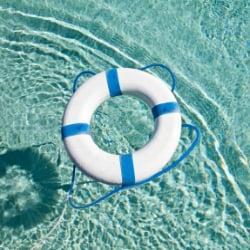
Drowning prevention is a team sport
30 June 2016
10 things you can do to avoid a devastating tragedy in the water
With summertime’s warm and sunny weather, children and teens are anxious to participate in a wide range of outdoor summer activities. Unfortunately, this is also the time of year when we hear about drownings occurring in children.
Drownings are preventable deaths but even the thought of them spooks most of us. That’s because often, a drowning event looks, sounds, and appears unlike we’d expect. Drowning isn’t at all like what is depicted in the movies. It is a silent death… it can happen very quickly. Young children are curious and do not have the judgment to identify an imminent risk. Older children and teens are at risk because they may tend to overestimate their skill level.
Drowning is the second leading cause of injury related death for Canadian children in the 1-4 age group and the 4th leading cause in children up to 14. According to the Canadian Red Cross every year approximately 60 children aged 14 and under drown and another 140 children are hospitalized after nearly drowning. It is reported that nearly 50% of drowning deaths occur around swimming pools, many in private homes with unfenced or inadequately fenced swimming pools.
But with the collaboration of parents and caregivers and communities, a number of measures can be taken to prevent drownings.
Plan ahead when children are around water:
1. Parental supervision: Quebec’s Lifesaving society recommends a supervision ratio of at least 1 adult per every 2 young children and 1 adult per baby. Vigilant supervision is essential in the prevention of drowning as it takes no time for a young child to drown in as little as 2.5 cm of water. Keep children within arm’s length. This means the focus of all attention is on the water with no distractions like texting, talking on the phone, reading, consuming alcohol or talking to a neighbor. Never leave children unattended in or near bodies of water, even for a moment.
2. Flotation devices: Children under 5 years old should wear a properly fitting personal floatation device. This also applies for older children and adults who do not know how to swim or are not strong swimmers. Babies who cannot sit without support and are too young to wear a portable flotation device (PFD) should be held by an adult at all times. Toddlers should always be within arm’s reach of an adult when they are in or around water. This includes pools, bathtubs, and beaches, and other water sources.
3. Swimming levels: Children should take swimming lessons, preferably at an early age. However, despite a child’s ability to swim, further precautions are still needed, as even strong and adequate swimmers have been known to drown. These include the use of floatation devices and attentive supervision.
4. Lifeguards: Inadequate supervision is among the most common risk factors associated with drowning. Even with lifeguards present, additional supervision adds another layer of protection against drowning. Lifeguards should not be substitutes for adequate supervision of children in bodies of water.
5. Daycamp/field trip supervision: Ensure children are properly supervised when going on a field trip to a pool, lake, or waterpark. Chaperones, as well as teachers and other staff need to understand their role in the supervision of children near water. Additional recommendations include the use of a buddy system, systematic counting of students and regular group gatherings during such field trips. While lifeguards and swimming lessons are vital safety tools, schools must take it upon themselves to provide increased supervision of their students during swimming activities and knowledge of skill level prior to embarking in the activity.
6. Home pool safety: Areas for swimming should be designated for that purpose. There should be no direct access to the pool from the house or patio. In-ground and above ground pools should be surrounded by 4-sided fencing (minimum height of 4ft or 1.2 m high) with automatic locking gates as Quebec provincial law requires that home pools installed since July 2012 must be enclosed by a locked fence. Always remember to empty kiddie pools when not in use.
7. Lake and beach safety: Obey all water safety regulations and warning signs when visiting lakes and beaches. In addition to careful supervision, ensure to verify the swimming skill level of all children present, use buddy systems and frequent counting checks when kids are in the water.
8. Boating: Always ensure all passengers wear proper fitting life jackets that meet safety standards. Never overload or stand in a boat, and ensure children are accompanied by adults. Check weather conditions ahead of an outing. It is not advisable to be on the lake in stormy conditions. Only exit a boat when it is fully docked.
9. Waterparks: when visiting water parks, supervision must be very attentive as injuries can happen fast. Remind users to clear the bottom of water slides quickly. Limit the number of people using the equipment at the same time. Equipment should be appropriate for a child’s age, height, and stage of development. Tie long hair back. Similarly, avoid wearing long necklaces and anything that could easily be caught in equipment.
10. Safety applies to adults too: No one is drown-proof, and safety precautions apply to adults just as much as they do to children. Ensure to be aware of individuals’ swim skill levels before entering a body of water, don’t consume alcohol around water, never swim alone and always ensure proper supervision to avoid injury.
For more resources on drowning prevention:
- https://www.thechildren.com/health-info/trauma/water-activities
- https://www.thechildren.com/sites/default/files/19052af_watersafety_epr7.pdf
- http://sante.gouv.qc.ca/en/conseils-et-prevention/prevenir-la-noyade/
